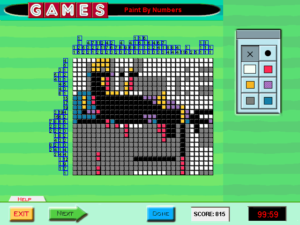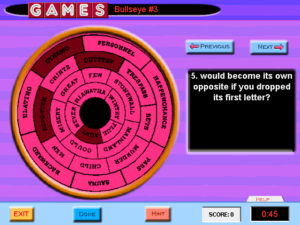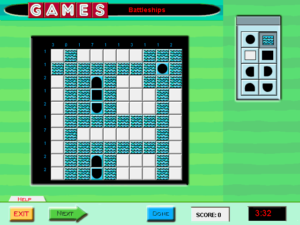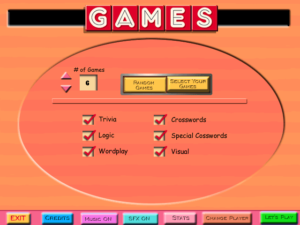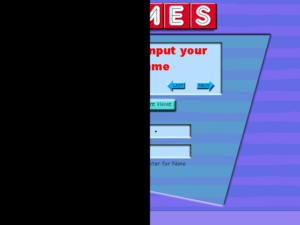Games Interactive: The Rest of Logic
Paint By Numbers must have been good training for Battleships, either in solving technique, or in attaining the right mindset, or simply in finding patience. Whatever the reason, I’ve managed to power my way through the rest of them.
Not that I got them all right. Oh, I had a good run of solutions that were recognized as perfect, but then suddenly it judged a couple in the last set as massively wrong. I’m not sure what to think about this. I said before that some puzzles were ambiguous, but I’m no longer convinced this is really true — it could just be that I failed to spot my own mistakes. Certainly my lengthy run of correctness suggests a lack of ambiguity in the puzzles, and in the ones I got correct, I often spotted and corrected inconsistencies just before submitting. On the other hand, there are enough outright mistakes in the game as a whole that it’s very easy to lose faith in its correctness. One of the trivia questions references a picture that isn’t included, at least one of the crosswords has a word that extends into a black square, at least one of the word puzzles under Special Crosswords contains typos in its word list that make it literally impossible to solve completely, and so on. Things that you’d expect QA to catch. But I suppose I’d trust the game about the Battleships more if I had a better idea of what it thought was wrong in my solutions. When you submit a Battleships solution, the game displays corrections highlighted in pink, but the corrections cover up what the grid was like before the corrections were applied.
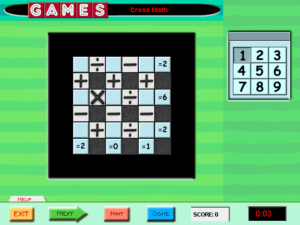 Battleships done, I finished going through the rest of the Logic section (apart from Paint By Numbers). The only repeated puzzle type I haven’t mentioned yet is “Cross Math”, which is sort of like a generalization of magic squares. You put the digits from 1 to 9 into a grid, but instead of each row and column having the same sum, each row and column must satisfy a unique equation. I find that these puzzles are best approached mainly through trial and error, aided by a certain amount of deductive reasoning to limit the number of possibilities, like “The first operation in this row is division, so either the first number is composite or the second number is 1”.
Battleships done, I finished going through the rest of the Logic section (apart from Paint By Numbers). The only repeated puzzle type I haven’t mentioned yet is “Cross Math”, which is sort of like a generalization of magic squares. You put the digits from 1 to 9 into a grid, but instead of each row and column having the same sum, each row and column must satisfy a unique equation. I find that these puzzles are best approached mainly through trial and error, aided by a certain amount of deductive reasoning to limit the number of possibilities, like “The first operation in this row is division, so either the first number is composite or the second number is 1”.
Then there are some one-offs, most of which aren’t really logic puzzles. Like, there’s one about matching dance step diagrams to their names, which seems like it belongs in the Trivia section to me. I was so dissatisfied with my score on this one that I retried it until I did it perfectly, and discovered that even perfection was rated as only 20% (or 50% with the time bonus). Presumably the wrong maximum score was entered for that puzzle. Just another of those little mistakes that make me lose faith in the thing.
Another of the puzzles belonged better under the Visual category. It shows a picture of a complex arrangement of gears, and asks which direction you have to turn a handle at one end of the whole chain to make the gear at the other end turn clockwise. The arrangement is three-dimensional, with gears at different angles, and the picture is so low-resolution that I was never quite sure what was going on in the joints where a shaft met another shaft at an angle. Nonetheless, I managed to get the right answer, if only because even a completely random guess comes out right half the time when there are only two possibilities.
There’s only one one-off puzzle in the Logic section that I’d call a proper logic puzzle, and it’s one of those ones where you have to figure out attributes of a group of objects on the basis of clues. Specifically, this one was themed around a television schedule, and had clues like “The shows that air at 8:00 on Tuesday through Friday have first letters that are alphabetically consecutive” and “The three shows with colors in their names all air on the same day”. This is a type of puzzle that’s only made less convenient by computerization. Solving it takes pencil and paper. The in-game grid of time slots doesn’t help particularly.
On my first attempt at this puzzle, I really thought I had run into ambiguity again. I had a partial solution that seemed to satisfy all of the clues, so any way of filling in the rest of the shows had to be valid. So I entered a solution, received a low score, and concluded that there must be a clue missing. Only the next morning did I think that I might have gotten a clue wrong, by thinking in terms of what’s showing at 10:00 when the clue was actually about what starts at 10:00. (Some of the shows are two hours long, so airing at 10:00 and starting at 10:00 are not the same thing.) And sure enough, paying attention to the exact wording revealed exactly that, and with that additional information I was able to solve the puzzle. So the mistake was mine, but on the other hand, it was way too easy to believe that the game had left out crucial information.
 Comments(1)
Comments(1)